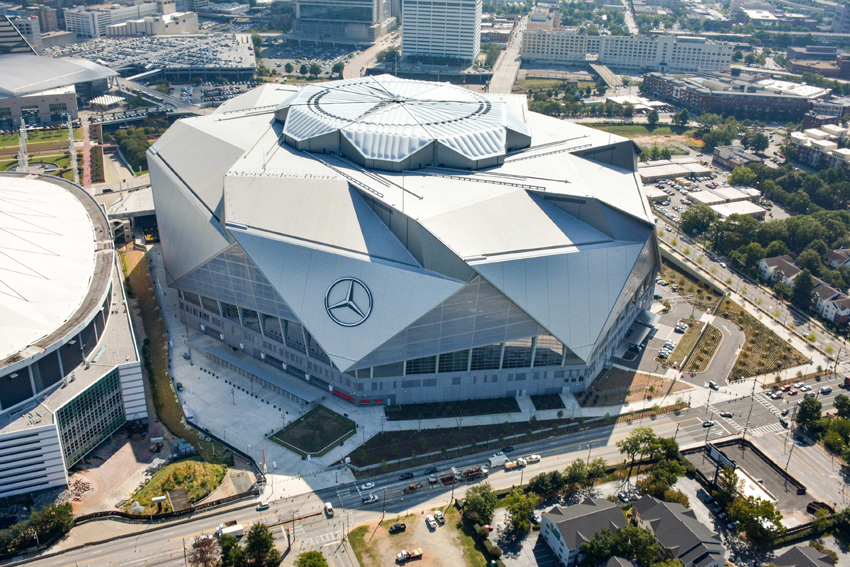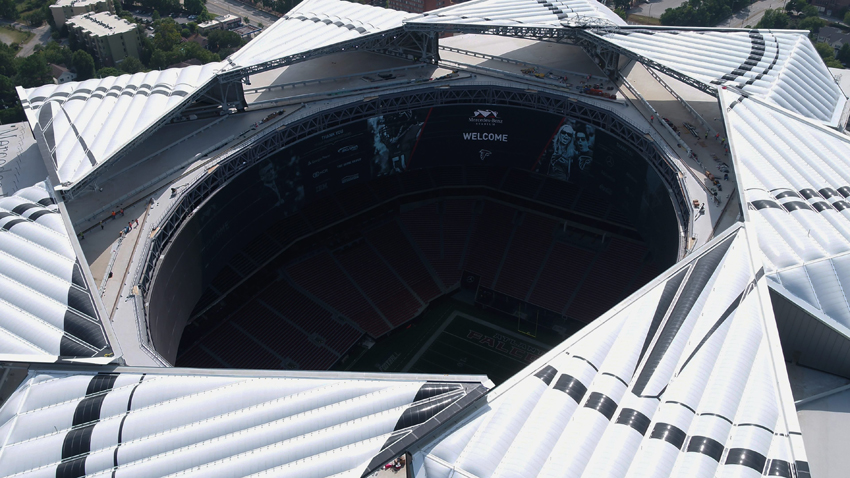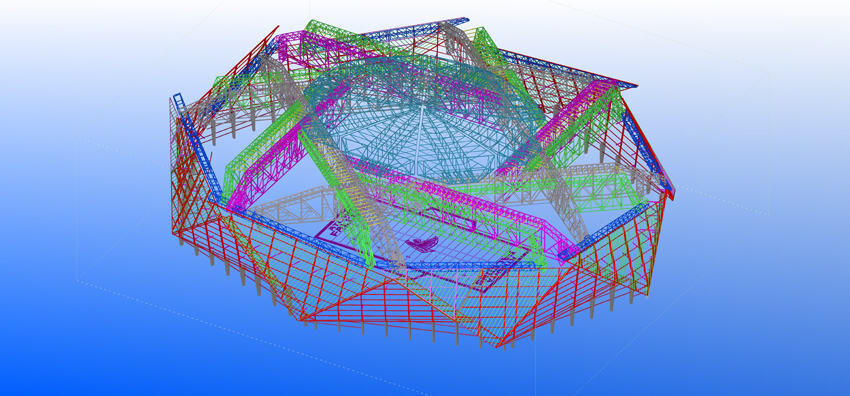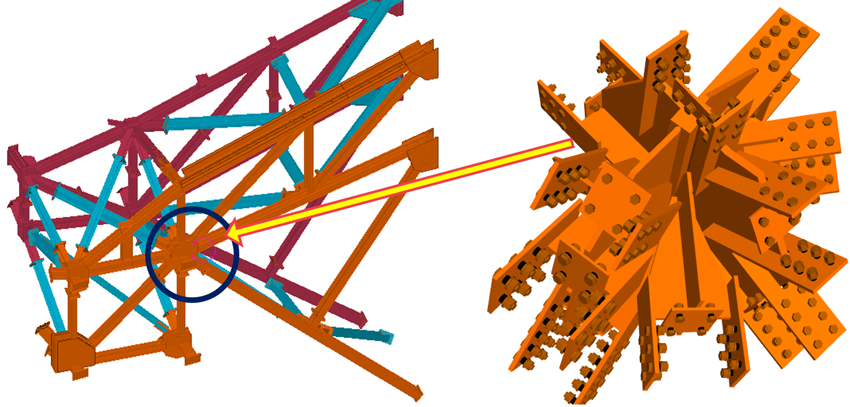Adapting to Change: Arenas Rely on Steel
Crown Corr then connected their secondary steel elements directly to this new member.
“Two anchors on the top and bottom of each of the 32 piers from which the structural steel space frame allows long spans—approximately 45 feet—support all additional secondary structure and finish cladding,” adds Cerone.
A wide-flange horizontal beam spanning the inner faces of the U-shaped pier holds the outrigger supports that intricately fits the aluminum cladding fins in the prefabricated metal space frame and attached it to the existing structure. Crown Corr’s structural lug comprises a W14x132 flange spanning 4-foot-wide welded end plates, which are bolted and epoxied to the concrete. Welded to the face of the W-flange are two match plates, from which 10-inch-diameter HSS tube frames provide welded ‘half-nodes’ for attaching adjacent space-frame panels. The attachment points are separated by approximately 9.5 feet of elevation. The space frame was assembled from HSS in diameters that vary from 2.375–3.5 inches according to tuned-to contextual loads and load paths. The chords were threaded into spherical nodes ranging from 3.5–7 inches in diameter.
The aluminum cladding material itself offered a high level of flexibility and was therefore easy to form into precise shapes. This, coupled with the cladding’s natural brushed finish, enabled SHoP Architects to create the aesthetic effect it was seeking.
“The aluminum finish picks up the ambient light and color well during different times of day and reflects the sky and sunset,” Cerone explains. “As the crowd moves into the Coliseum, colors from their clothes and the surrounding trees also get reflected into the material.”
The project’s main challenge was the juxtaposition of the existing structure’s regular geometry with the new facade’s undulating surface, which required the new structural elements to take the form of the new shape and transfer its load back to the existing column grid. “The ability of steel to span the large distances between the existing concrete columns with a lightweight structure was critical to minimizing the cost to the reclad and minimized the load imposed on the existing building,” Callow explains.
Mercedes-Benz Stadium
Opened in 2017, Atlanta’s Mercedes-Benz Stadium designed by HOK features a pinwheel-style retractable roof—an architectural gesture inspired by the oculus in the roof of Rome’s Pantheon—made possible by an intricate and highly integrated feat of engineering.

Photo courtesy of AMB Sports & Entertainment
Atlanta’s Mercedes-Benz Stadium features a highly intricate pinwheel-style retractable roof, a unique two-way spanning truss system, and single-skin ETFE facade panels.
Made from facade panels clad in single-skin ETFE (ethylene tetrafluoroethylene), the transparent, inflated lightweight material exerts minimal weight on the eight long-span cantilevered moving petals, which open and close in under 10 minutes.

Photo courtesy of AMB Sports & Entertainment
Mercedes-Benz Stadium’s unique roof features eight long-span cantilevered moving petals that can open or close in under 10 minutes.
As stated in a Buro Happold blog, as the structural engineer on this massive, $1.6-billion project, “the complex geometry of the facades, framed with elegant lightweight steel, help to create an iconic exterior.”
The uniquely designed roof incorporates a two-way spanning truss system, which is unusual for a long-span roof. According to Yasmin Rehmanjee, PE, SE, LEED AP, principal, Buro Happold, New York, each truss is 70 feet deep and reframed with a 12-foot-square top chord truss box consisting of four chord members, with the tension chord 58 feet below. “The roof structure is framed with four primary trusses that span 723 feet and provide support to the downward force from the cantilevered, moveable panels,” she says.

Image courtesy of Buro Happold
This structural steel Tekla model consists of about 70-foot-deep trusses with 12-foot top chord box trusses comprising four chord members, with the tension chord 58 feet below. Four primary trusses span 723 feet to support the entire fixed roof as well as the cantilevered, moveable panels.
In addition, secondary trusses support the uplift rails for the moving petals. Both 65-ksi and 50-ksi steel were used, which included the newest available jumbo shapes (W14×873) at the time.
From the project’s onset, the design team set out to conceive an unprecedented operable roof—using more moving pieces and smaller spans with the intention of creating an opening that operates faster than any other retractable roof in an eye-catching manner.
“Despite giving a visual effect similar to a camera shutter when opening, each of the petals moves along straight tracks on the fixed roof,” Rehmanjee explains. “Constant and in-depth information exchange is required between the structural engineer and the mechanization contractor to ensure that the mechanization is capable of handling the loads imposed by the moveable panels.”
In describing the intricate engineering that went into achieving this, Bill Darden, president of Darden & Company, the project management firm overseeing development of the stadium, compared the construction to a Swiss watchmaker working with micro-ounce pieces that are so small you can barely even know they are in your hand, with one major difference. In this case, “there are 4,000 tons of steel in these eight petals, and we are trying to accomplish the same exact thing because these pieces have to move at the exact precise time and must have very tight tolerances between the bogies and rails. It is very precise…we are literally talking about 1⁄16 and 1⁄32 of an inch,” explains Darden in an interview with the Atlantic Journal-Constitution.
In addition to the challenge of supporting eight moving roof panels, the roof trusses had to be placed in such a way as to not block the roof opening but rather frame the 60-foot-tall halo video board at the stadium.
The board itself is quite remarkable. Called the Halo Board, it is a 360-degree, 58-foot-tall, high-definition LED video display delivering an immersive and theatrical experience whether the roof is open or closed.
To create this impressive new stadium with its 72,000 seats, 18,000 tons of structural steel was used for the fixed roof, 4,000 tons went into the retractable portion, another 4,000 tons make up the ‘skin’ of the building, and 580 tons support the video board.

Image courtesy of Buro Happold
This 3-D image shows a connection detail of the complex steel nodes for trusses in which several members frame into a single location. The Mercedes-Benz Stadium roof structure includes both 65-ksi and 50-ksi steel, as well as the newest jumbo shapes at the time, W14×873.
Rehmanjee describes the importance of understanding how the structure will be built while correctly accounting for the forces that get locked into the structure during construction—a crucial part of the project delivery process. One part of this equation is the structural engineer making an assumption about construction sequence, which must be communicated to key contractors when they come on board. In the case that the contractor changes the construction sequence to suit their preference, it is of utmost importance that the roof design is reevaluated for the revised sequence to ensure that the members and connections are still capable of resisting any changes to load demand.









